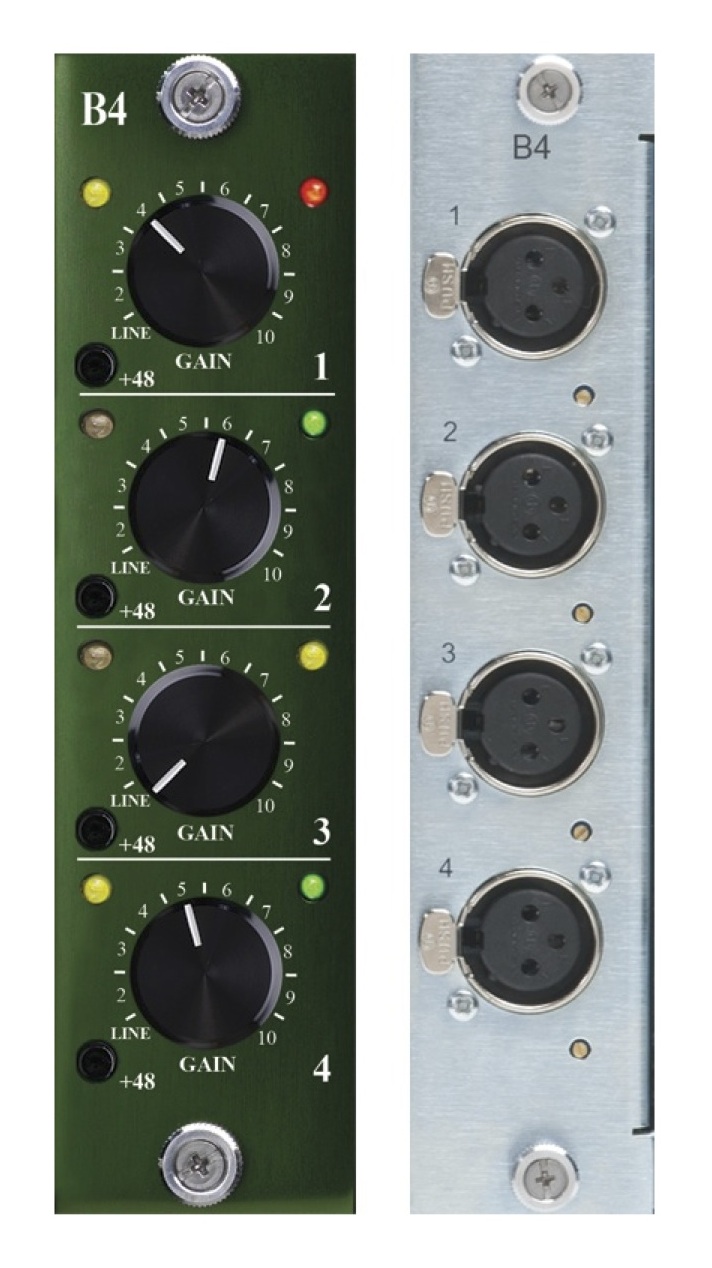New Gear Review: B4 Mic Pre A/D Daughter Card by Burl
Hopefully by now you have all heard of Burl and the B80 Mothership, the customizable and modular A/D-D/A interface. Since its release, the Mothership has been highly regarded by many producers, engineers, mixers, and mastering engineers. It has been said that the Burl sound has a “palpable, analogue-like coloration and provides next-level performance.”
Burl has just released a new daughter card for the Mothership: The B4 Mic Pre A/D Daughter Card. Now, B4 I tell you any more (bad pun intended), it could be helpful to read my 2017 review of the B16 Mothership, which covers the basics of the unit’s functionality, along with putting it to the test in real-world applications.
Unlike previous offerings, the B4 was primarily designed for live sound applications, taking Burl’s pristine reputation for remarkable sound quality from the studio to the stage. Now let’s see what the B4 is all about.
The Basics
The B4 daughter card is a four-channel microphone preamp and A/D converter card built for the Burl Motherships. It has four XLR inputs on the rear and Burl’s signature green faceplate with four detented knobs. Also found on the faceplate are two LEDs for each channel: one that shows input level, and one to show when phantom power is on. There is also a small button to engage phantom power. If you want more detailed specs, they can be found here.
B4 Shoot-Outs
Given my familiarity with Burl products, I was excited to hear the B4 in action. I did two basic comparisons: I wanted to be able to compare the preamp section of the card independently from the A/D process, so I used one channel on the B4 as a mic pre, and another, set to line input, for the other. In both circumstances I used a Radial Pro MS2 microphone splitter. I wanted to use the Pro MS2 as opposed to a Y cable or mult-ing to ensure that I wasn’t introducing any ground loops or additional noise into the chain.
The first shoot-out I did was during a tracking session at Sear Sound, capturing a band live with everyone in the same room. I had the singer on a Beyerdynamic M88 running into the Radial Pro MS2, then one line running to the Burl B4 and the other running to an Avalon preamp (inside a Sony console).
I set the gains by ear, as both preamps have detented knobs. I also used the preamp output from the console, so as not to introduce any other coloration from the console path. I had a quick listen during the tracking session and the difference was immediately noticeable. After the session I had more time to explore the differences, making sure the gains were exactly matched (I had to raise the Avalon level .1dB).
Now here is where we inevitably begin to use the vague and subjective “audio terms” that come with the review of a sound-based product. I could say that the Burl had more “air”, was more “alive” and “open” or something like that, but instead I’ll just say the high end seemed to extend beyond that of the Avalon, giving the impression of all of the above.
In the second shoot-out, the B4 was up against an API preamp form the early 70s. I wasn’t expecting this to be as close of a match as the Avalon and the B4, but thought it might be nice to have some perspective. This time I had Zach Brock, the violinist from Snarky Puppy, give a few minutes of Violin at Pyramid Recording.
I began with an omni Earthworks mic (the model number of which can’t be mentioned as it’s a Beta and I signed an NDA). Again, the signal chain ran the mic through the Radial Pro MS2, and to no surprise the result was as follows: the B4 provided much more clarity on the top end, and was brighter overall. That’s not to say that the API was bad by any stretch. I actually might have preferred the API for certain applications, but the difference in “openness” was quite apparent.
To Be Critical
One thing that was bothering me about the B4 was the fact that the gain knobs were mounted to the faceplate of the convertor. In most studios, the interface is located either in a machine room or in an out-of-the-way spot in the racks. I gave Will at Burl a quick call because I thought there might be something I was missing. Indeed there was! The gain knob is analog, but it controls a digital circuit. This means that in the near future, the preamp will be controllable remotely.
One other function I found the B4 was lacking was an insert point. Personally, I love tracking with EQ, compression, and effects to “tape”. According to Burl, “There are no plans for this at the moment.”
Summing it Up
In conclusion, I found the Burl B4 to be clean and pristine! Priced at $2,199 for four channels of conversion, it’s a little on the high end for most home recording setups, but it does sound good and I think it will be adopted by many professional engineers and studios, and see a lot of action on stage as well.![]()
I imagine this would be an excellent preamp in the world of classical recording too. I’m not sure if those in that world have cottoned on to Burl yet, but next time I record an orchestra, I’d love to have 60 channels of B4. Well done, Burl!
Please note: When you buy products through links on this page, we may earn an affiliate commission.







